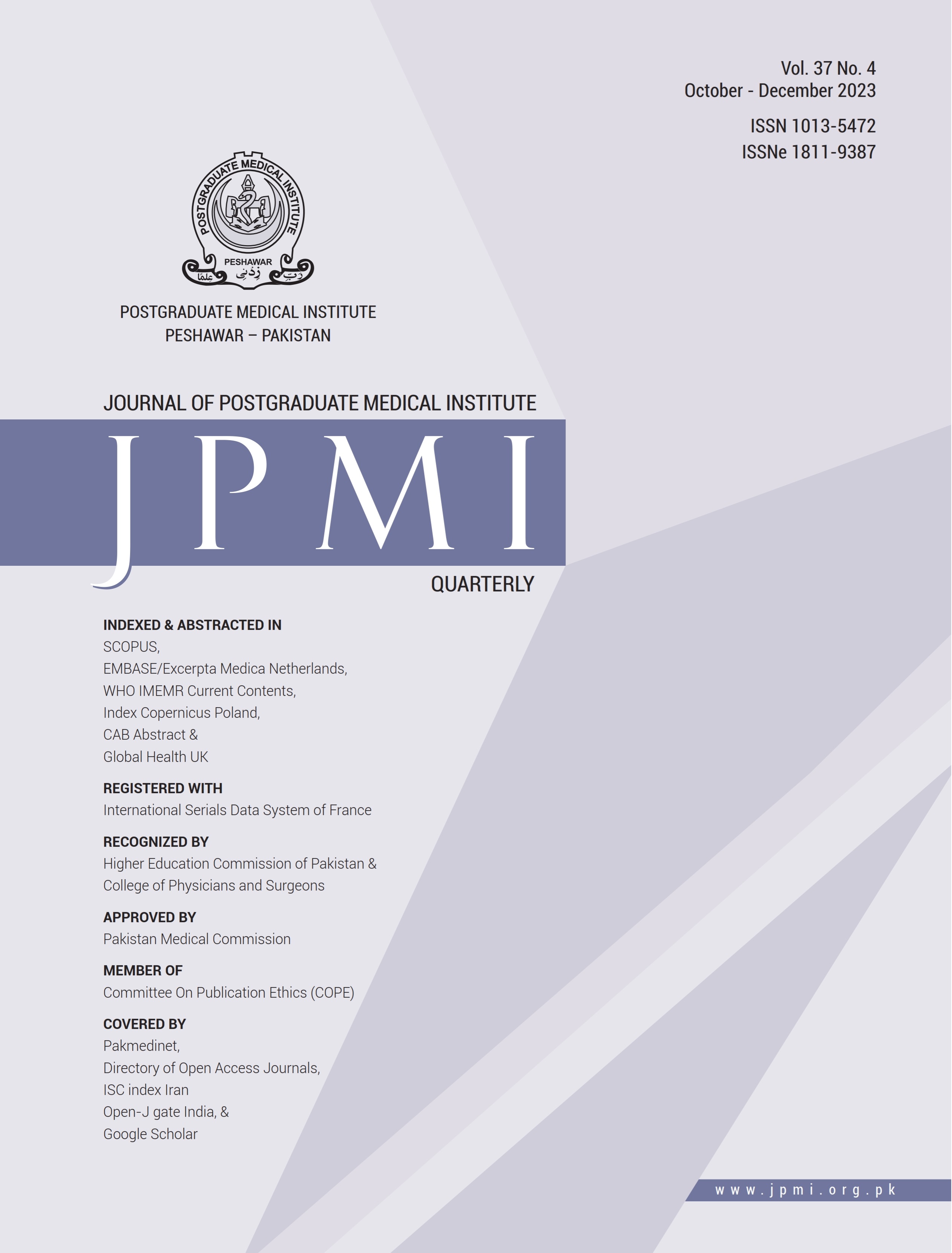FREQUENCY OF DIFFERENT PALATAL RUGAE PATTERNS IN MIXED DENTITION PATIENTS
Main Article Content
Abstract
Objective: To assess the pattern of palatal rugae in mixed dentition subjects based on Angle’s classification of malocclusions.
Methodology: Pre-treatment high quality white orthodontic stone models of 102 subjects, 55 males and 47 females were selected to conduct a cross-sectional study at Peshawar. Pattern, length and orientation of palatal rugae of all subjects included in the study were assessed using the proposed method of Thomas and Kotze for classification of palatal rugae. The mean, standard deviation and percentages were measured using SPSS Version 20.0. The mean highest length of second right side rugae was recorded 7.9020mm.
Results: The study revealed significant differences in palatal rugae patterns based on gender (x2 = 6.016, df = 5, p = .305). The orientation of horizontally directed rugae was predominant (55.9%), followed by posteriorly (26.5%) and anteriorly directed (17.6%) rugae. Furthermore, the analysis showed notable associations between malocclusion classification and primary rugae count, length, orientation, and pattern.
Conclusion: This study underscores the pivotal role of palatal rugae in accurate person identification, forensics, and dental records administration. The unique characteristics of palatal rugae hold substantial promise in forensic dentistry, enhancing our understanding of their distinct attributes and applications.
Article Details
Work published in JPMI is licensed under a
Creative Commons Attribution-NonCommercial 2.0 Generic License.
Authors are permitted and encouraged to post their work online (e.g., in institutional repositories or on their website) prior to and during the submission process, as it can lead to productive exchanges, as well as earlier and greater citation of published work.
References
Heydari F, Gholinia H, Ghorbanipour R. Evaluation of palatal rugae pattern in different sagittal skeletal relation¬ships in orthodontic patients. Caspian J Dent Res. 2021;10(2):45-51. DOI: 10.22088/cjdr.10.2.45.
Pazera C, Gkantidis N. Palatal rugae positional changes during orthodontic treatment of growing patients. Orthod Craniofac Res. 2021;24(3):351-9. DOI: 10.1111/ocr.12441.
Fatima F, Fida M, Shaikh A. The asso¬ciation between palatal rugae pattern and dental malocclusion. Dent Press J Orthod. 2019;24:037e1-9. DOI: 10.1590/2177-6709.24.1.37.e1-9. onl .
Bataille A, Le Gall C, Misery L, Talagas M. Merkel Cells Are Multimodal Sensory Cells: A Review of Study Methods. Cells. 2022;11(23):3827. DOI: 10.3390/ cells11233827.
Sapasetty S, Gandikota C. Assessment and Correlation of Dactyloscopy, Chei¬loscopy, and Rugoscopy Among Individ¬uals With Different Skeletal Malocclu¬sion - A Cross-Sectional Study. J Indian Orthod Soc. 2022: 57(3):156-70. DOI: 10.1177/03015742221122628.
Lanteri V, Cossellu G, Farronato M, Ugo¬lini A, Leonardi R, Rusconi F, et al. As¬sessment of the stability of the palatal rugae in a 3D-3D superimposition tech¬nique following Slow Maxillary Expan¬sion (SME). Sci Rep. 2020;10(1):2676. DOI: 10.1038/s41598-020-59637-5.
Ginart MT. Assessment of palatal rugae in a multiethnic population. Diss. The University of Iowa; 2020.
Tiwari AK, Shreedhar B, Khare A, Khan S, Siddiqui A, Ghimire P, et al. Reliability assessment of combination approach for gender identification using cheilos¬copy and dactyloscopy–A comparitive study. J Forensic Odontol. 2022;7(2):1- 8. DOI: 10.56501/intjforensicodontol. v7i2.543.
Said KN, Abu Khalid AS, Farook FF. Distal extension of palatal rugae as a limitation for donor soft tissue grafts in a Jordani¬an population: A cross-sectional study. BMC Oral Health. 2021;21(1):203. DOI: 10.1186/s12903-021-01561-9.
Sassouni V. A roentgenographic cephalometric analysis of cepha¬lo-facio-dental relationships. Am J Orthod. 1955;41(10):735-64. DOI: 10.1016/0002-9416(55)90171-8.
Monterrey Rodríguez JT. A Libament to Your Palate: Narrative Form, History and Gender in Eliana. A New Romance. 2019;79: 123-44. DOI: 10.25145/J. recaesin.209.79.08.
Kasuma N, Fitriana A, Fajrin FN. Palatal rugae pattern identification to deter¬mine family lineage in Minangkabau, West Sumatera, Indonesia. Indian J Fo¬rensic Med Toxicol. 2014;12:1-7.
Neela PK, Atteeri A, Mamillapalli PK, Se¬sham VM, Keesara S, Chandra J, et al. Genetics of dentofacial and orthodon¬tic abnormalities. Global J Med Genet. 2020;7(4):095-100. DOI: 10.1055/s- 0040-1722303.
Obniski M. An investigation of palatal rugae patterns and torus palatinus in unaffected relatives of individuals with orofacial clefts: The University of Iowa; 2020.
Saraf A, Bedia S, Indurkar A, Degwekar S, Bhowate R. Rugae patterns as an adjunct to sex differentiation in foren¬sic identification. J Forensic Odonto Stomatol. 2011;29(1):14.
Gondivkar SM, Patel S, Gadbail AR, Gaikwad RN, Chole R, Parikh RV. Mor¬phological study of the palatal rugae in western Indian population. J Foren¬sic Leg Med. 2011;18(7):310-2. DOI: 10.1016/j.jflm.2011.06.007.
Kallianpur S, Desai A, Kasetty S, Sud¬heendra U, Joshi P. An anthropometric analysis of facial height, arch length, and palatal rugae in the Indian and Nep¬alese population. J Forensic Dent Sci. 2011;3(1):33.
Mounika G, Sahi BK, Deepika A, Harika N, Malyadri A. Palatal Rugae Pattern in Gender Identification - A Forensic Study. Int J forensic Odontol. 2022;7(1):47- 57. DOI: 10.56501/intjforensicodontol. v7i1.175.
Lysell L, Rohlin M. A study of indications used for removal of the mandibular third molar. Int J Oral Maxillofac Surg. 1988;17(3):161-4.
Faisal MF, Yousif FT. Rugae pattern in a Saudi population sample of males and females.Saudi Dent J.2001;13(2):92-5.
Shetty M, Premalatha K. Study of pal¬atal rugae pattern among the student population in Mangalore. J Indian Acad Forensic Med. 2011;33(2):112-5.
Rahebi D, Naghavialhosseini A, Pak¬khesal M, Rajabi A, Mirzaei F, Salim NA, et al. Palatal Rugae Patterns in Fars, Turkmen, and Sistani Ethnicities in the Eastern Part of the Caspian Littoral of Iran. Diagnostics. 2023;13(2):200. DOI: 10.3390/diagnostics13020200.


